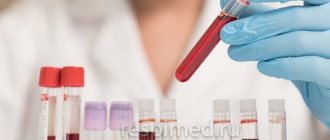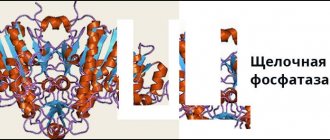What will happen in the video:
1. What are monocytes |
00:22 (in video) 2. Normal monocytes in the blood | 02:49 (in video) 3. Reasons for the increase in monocytes in the blood | 03:42 (in video) 4. Symptoms of increased monocytes in the blood | 06:58 (in video) 5. Increased monocytes in children (monocytosis in children) | 10:39 (in video) Online consultation with infectious disease specialist, allergist-immunologist Natalia Nikolaevna Gordienko
Cost of online consultation: 3500 rubles
Online consultation
During the consultation, you will be able to voice your problem, the doctor will clarify the situation, interpret the tests, answer your questions and give the necessary recommendations.
Read more about blood tests in our article
“Hematological tests: norms and interpretation of results.”
Tests mentioned in the article
| General blood analysis | Reticulocyte count | Hemostasiogram |
| APTT | Prothrombin time | Antithrombin III |
| Protein C | Aggregation with ristocetin | Serum iron |
| Ferritin | Transferrin | Fibrinogen |
| Antigroup antibodies | Rh antibodies | Erythropoietin |
How to take blood tests and get a 5% discount? Visit the online store of CIR laboratories!
Blood plasma volume
By 6-12 weeks of pregnancy, blood plasma volume increases by approximately 10-15%. The fastest rate of increase in blood plasma volume is observed in the period from 30 to 34 weeks of pregnancy, after which plasma volume changes slightly. On average, blood plasma volume increases by 1100-1600 ml per trimester, and as a result, plasma volume during pregnancy increases to 4700-5200 ml, which is 30 to 50% higher than plasma volume in non-pregnant women.
During pregnancy, plasma renin activity tends to increase, while the level of atrial natriuretic peptide decreases slightly. This suggests that the increase in plasma volume is caused by vascular insufficiency, which is caused by systemic vasodilation (dilation of blood vessels throughout the body) and an increase in vascular capacity. Since it is the volume of blood plasma that initially increases, its effect on the renal and atrial receptors leads to opposite effects on hormonal levels (a decrease in plasma renin activity and an increase in natriuretic peptide). This hypothesis is also supported by the observation that increasing sodium intake does not further increase plasma volume.
After delivery, plasma volume decreases immediately but increases again after 2–5 days, possibly due to increased aldosterone secretion occurring at this time. Plasma volume then gradually declines again: at 3 weeks postpartum it is still elevated by 10-15% relative to the normal level for non-pregnant women, but is usually completely normal by 6 weeks postpartum.
Interpretation of the INR analysis
The interpretation of the INR analysis is carried out exclusively by the patient’s attending physician, because he knows the characteristics of his body, medical history and medications that the person takes, which can affect the INR value.
Table 2. INR values and their possible interpretation
| The resulting indicator | Decoding |
| 0,85—1,15 | INR norm for a patient who does not have diseases of the blood coagulation system: coagulation processes are normal. |
| 2—3 | Elevated INR: the patient is probably taking anticoagulant therapy (Warfarin) due to the presence of a certain pathology - for example, atrial fibrillation; the person is undergoing treatment for pulmonary embolism; The patient is prescribed treatment due to the occurrence of thrombosis or to prevent thrombosis of large veins. |
| 2,5—3,5 | Such data are observed after installation of a mechanical mitral valve prosthesis in a patient. |
| 3,0—4,5 | This INR indicator indicates the development of diseases of the patient’s vascular bed, as well as myocardial infarction. |
It is recommended to draw conclusions about the state of the blood coagulation system based on INR analysis over time, after a series of studies. It is in this way that the doctor obtains the most complete picture of the patient’s health.
Red blood cells during pregnancy, ESR during pregnancy
The number of red blood cells begins to increase at 8-10 weeks of pregnancy and by the end of pregnancy it increases by 20-30% (250-450 ml) relative to the normal level for non-pregnant women, especially in women who took iron supplements during pregnancy. Among pregnant women who did not take iron supplements, the number of red blood cells may increase only by 15-20%. The lifespan of red blood cells decreases slightly during normal pregnancy.
The level of erythropoietin during normal pregnancy increases by 50% and its change depends on the presence of pregnancy complications. An increase in plasma erythropoietin leads to an increase in the number of red blood cells, which partially meet the high metabolic oxygen requirements during pregnancy.
In women who do not take iron supplements, the average volume of red blood cells decreases during pregnancy and in the third trimester averages 80-84 fL. However, in healthy pregnant women and in pregnant women with moderate iron deficiency, the average volume of red blood cells increases by approximately 4 fL.
ESR increases during pregnancy, which has no diagnostic value.
Iron requirement
In a singleton pregnancy, the iron requirement is 1000 mg per pregnancy: approximately 300 mg for the fetus and placenta and approximately 500 mg, if present, to increase hemoglobin. 200 mg is lost through the intestines, urine and skin. Since most women do not have adequate iron stores to meet their needs during pregnancy, iron is usually prescribed in a multivitamin or as a separate element. In general, women taking iron supplements have a hemoglobin concentration that is 1 g/dL higher than women not taking iron.
Thrombocytopenia during pregnancy
The most obstetrically important change in platelet physiology during pregnancy is thrombocytopenia, which may be associated with pregnancy complications (severe preeclampsia, HELLP syndrome), drug disorders (immune thrombocytopenia), or may be gestational thrombocytopenia.
Gestational or accidental thrombocytopenia occurs asymptomatically in the third trimester of pregnancy in patients without previous thrombocytopenia. It is not associated with maternal, fetal or neonatal complications and resolves spontaneously after delivery.
Indications for examination
As part of a general blood test, monocytes are determined by:
- at your first visit to the doctor (usually up to 12 weeks);
- at 30 weeks.
Indications for additional examination;
- acute infectious diseases;
- exacerbation of chronic pathology;
- suspicion of autoimmune diseases or control of already identified processes;
- prolonged course of acute infection (more than 14 days);
- preparation for surgery;
- control of blood counts in the postoperative period;
- suspicion of intrauterine infection of the fetus;
- hospitalization in hospital for any complications of pregnancy;
- preparation for physiological or surgical childbirth.
The indications are determined by the attending physician after the initial examination.
Leukocytes during pregnancy
During pregnancy, leukocytosis is observed, mainly associated with an increase in circulating neutrophils. The number of neutrophils begins to increase in the second month of pregnancy and stabilizes in the second or third trimesters, at which time the number of leukocytes increases from 9*10^9/l to 15*10^9/l. The white blood cell count decreases to the reference interval for non-pregnant women by the sixth day after delivery.
In the peripheral blood of pregnant women there may be a small number of myelocytes and metamyelocytes. According to some studies, there is an increase in the number of young forms of neutrophils during pregnancy. Lobular bodies (blue staining of cytoplasmic inclusions in granulocytes) are considered normal in pregnant women.
In healthy women during uncomplicated pregnancy, there is no change in the absolute number of lymphocytes and no significant changes in the relative number of T and B lymphocytes. The number of monocytes usually does not change, the number of basophils may decrease slightly, and the number of eosinophils may increase slightly.
Pregnancy management tactics
If the number of monocytes in the blood changes, additional examination is indicated:
- blood chemistry;
- general urine analysis;
- bacteriological examination of urine;
- microscopy and culture of genital tract discharge;
- immunological blood tests if an autoimmune process is suspected;
- Ultrasound of internal organs (emphasis on the pelvic organs, urinary system);
- ECG.
Further tactics will depend on the diagnosis:
- Consultation with a specialized specialist - therapist, rheumatologist, hematologist, etc.
- Treatment of identified pathology taking into account the duration of pregnancy. After eliminating the cause, the level of monocytes returns to normal. In some conditions (protracted infections, autoimmune processes), changes in blood tests persist up to 2-4 weeks after recovery.
- Assessment of fetal condition. In the early stages, ultrasound with Doppler ultrasound is prescribed. After 32 weeks, cardiotocography is performed. If pregnancy complications are identified, their treatment is indicated. Childbirth is carried out taking into account the diagnosis.
A control blood test is prescribed two weeks after completion of the course of therapy. If changes in the blood persist, you need to change treatment tactics.
Clotting factors and inhibitors
During normal pregnancy, the following changes in the levels of coagulation factors occur, leading to physiological hypercoagulability:
- Due to hormonal changes during pregnancy, the activity of total protein S antigen, free protein S antigen and protein S decreases.
- Resistance to activated protein C increases in the second and third trimesters. These changes were detected in first-generation tests using pure blood plasma (i.e., not lacking factor V), but this test is rarely used clinically and is of only historical interest.
- Fibrinogen and factors II, VII, VIII, X, XII and XIII increase by 20-200%.
- The von Willebrand factor increases.
- The activity of fibrinolysis inhibitors, TAF1, PAI-1 and PAI-2 increases. The level of PAI-1 also increases noticeably.
- Levels of antithrombin III, protein C, factor V and factor IX most often remain unchanged or increase slightly.
The end result of these changes is an increased tendency to thrombus formation, an increase in the likelihood of venous thrombosis during pregnancy and, especially, in the postpartum period. Along with myometrial contraction and increased tissue decidual factor levels, hypercoagulability protects the pregnant woman from excessive bleeding during labor and placental separation.
APTT remains normal throughout pregnancy but may decrease slightly. Prothrombin time may be shortened. Bleeding time does not change.
The timing of normalization of blood clotting activity in the postpartum period may vary depending on factors, but everything should return to normal within 6-8 weeks after birth. The hemostasiogram does not need to be assessed earlier than 3 months after birth and after completion of lactation to exclude the influence of pregnancy factors.
The influence of factors of acquired or hereditary thrombophilia on pregnancy is an area for research.
How to determine monocytes in the blood
Monocytes are determined together with other cells in the structure of a general blood test (CBC). Examination rules:
- Blood for analysis is taken from a finger or from a vein. The latter option is preferable - this way the blood cells are damaged less and the examination results are less likely to be distorted.
- It is better to donate blood in the morning after an 8-hour fast. It is allowed to donate blood in the afternoon, 3-4 hours after a light snack.
- The day before the examination, you need to exclude physical activity and emotional experiences - they reduce the level of monocytes.
- You should not smoke half an hour before donating blood.
Monocytes are determined by a laboratory assistant manually or using a hardware method. The form usually presents blood values as percentages, less often – in absolute values. The results are deciphered by a gynecologist or therapist.
Hematological complications during pregnancy
- Iron-deficiency anemia.
- Thrombocytopenia.
- Neonatal alloimmune thrombocytopenia.
- Acquired hemophilia A.
- Venous thrombosis.
- Rh and non-Rh alloimmunization. For diagnosis, an analysis is performed for Rh antibodies and anti-group antibodies.
- The manifestation of a previously unrecognized disorder of the coagulation system, such as von Willebrand disease, most often manifests itself in women during pregnancy and childbirth. To screen for von Willebrand disease, a test is performed to evaluate platelet aggregation with ristocetin.
- Aplastic anemia.
Tags:
complete blood count, anemia, pregnancy, iron, platelets, erythrocytes, leukocytes
Back to section









